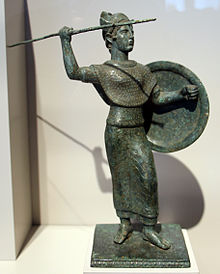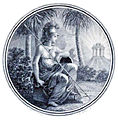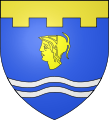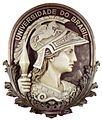Minerva
![]()
The title of this article is ambiguous. For other meanings, see Minerva (disambiguation).
Minerva is a Roman goddess who was especially worshipped by the Sabines, Etruscans and Latins. The Etruscans called her Menrva. The Greek goddess Athena corresponds to her.
In the Roman Empire, Minerva was initially regarded as the protector of craftsmen and tradesmen. Later, elements of the Greek cult of Athena were adopted into the image of Minerva, thus she also became the patron goddess of poets and teachers. Minerva was the goddess of wisdom, tactical warfare, art and shipbuilding, and guardian of knowledge. Since Augustus she has been worshipped as the goddess bestowing victory or guiding the fortunes of the state. A particular devotee of Minerva was the emperor Domitian, who often had her depicted on the reverse of his coins (see photo right).
In Rome, Minerva was worshipped as one of the three city deities on the Capitol, along with Jupiter and Juno. Her temple once stood in the middle of the Aventine Hill. Today, however, no remains of it survive. A second temple was located - also since Republican times - on the Esquiline. This was dedicated to Minerva Medica, the patron goddess of physicians. A third temple was located on the Caelius. This was named "Temple of Minerva Capta" because the cult image had been stolen by the Romans from the conquered Falerii in 241 BC.
The main festival of Minerva, the Quinquatrus (March 19, later from March 19 to March 23), was especially celebrated as a craftsmen's festival by guilds and guilds. In the 18th century, due to the elements of this festival and some other references, the Minerva celebrations were thought to be precursors of the Gregorius processions.
·
Head of Minerva (2nd century)
· 
Relief of the Minerva from Herculaneum
· 
Head of Minerva (Roman Museum Avenches)
· 
Statue of Minerva (Museo Nazionale Romano)

Minerva on denarius of the emperor Domitianus

Etruscan Menerva Statuette

Minerva of Peace , mosaic by Elihu Vedder (1896) in the Library of Congress
Heraldry
The image of Minerva (as well as that of Athena) has been used in heraldry, on coats of arms and seals since the time of Renaissance humanism. Among other things, it is the symbolic emblem of the Max Planck Society and the signet of its predecessor, the Kaiser Wilhelm Society. It can also be found on the Californian seal. She serves as the guardian of knowledge on the coats of arms and seals of the University of Brazil in Rio de Janeiro, the Hotchkiss School and numerous Spanish military schools.
· 
Minerva as Leipzig Masonic symbol
· 
Minerva head in heraldry (here: town coat of arms of Maisons)
· 
Minerva as patron saint of the University of Rio de Janeiro
· 
Minerva image on Confederate-American 100 dollar bill (right)
See also
Owl of Minerva
Search within the encyclopedia
